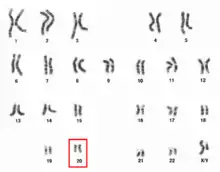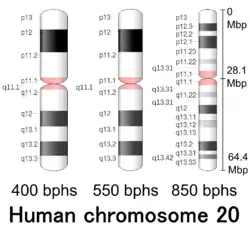Chromosome 20
Chromosome 20 is one of the 23 pairs of chromosomes in humans. Chromosome 20 spans around 63 million base pairs (the building material of DNA) and represents between 2 and 2.5 percent of the total DNA in cells. Chromosome 20 was fully sequenced in 2001 and was reported to contain over 59 million base pairs.[5] Since then, due to sequencing improvements and fixes, the length of chromosome 20 has been updated to just over 63 million base pairs.[6]
| Chromosome 20 | |
|---|---|
 Human chromosome 20 pair after G-banding. One is from mother, one is from father. | |
 Chromosome 20 pair in human male karyogram. | |
| Features | |
| Length (bp) | 64,444,167 bp (GRCh38)[1] |
| No. of genes | 516 (CCDS)[2] |
| Type | Autosome |
| Centromere position | Metacentric[3] (28.1 Mbp[4]) |
| Complete gene lists | |
| CCDS | Gene list |
| HGNC | Gene list |
| UniProt | Gene list |
| NCBI | Gene list |
| External map viewers | |
| Ensembl | Chromosome 20 |
| Entrez | Chromosome 20 |
| NCBI | Chromosome 20 |
| UCSC | Chromosome 20 |
| Full DNA sequences | |
| RefSeq | NC_000020 (FASTA) |
| GenBank | CM000682 (FASTA) |
Genes
Number of genes
The following are some of the gene count estimates of human chromosome 20. Because researchers use different approaches to genome annotation their predictions of the number of genes on each chromosome varies (for technical details, see gene prediction). Among various projects, the collaborative consensus coding sequence project (CCDS) takes an extremely conservative strategy. So CCDS's gene number prediction represents a lower bound on the total number of human protein-coding genes.[7]
| Estimated by | Protein-coding genes | Non-coding RNA genes | Pseudogenes | Source | Release date |
|---|---|---|---|---|---|
| CCDS | 516 | — | — | [2] | 2016-09-08 |
| HGNC | 519 | 191 | 297 | [8] | 2017-05-12 |
| Ensembl | 540 | 594 | 247 | [9] | 2017-03-29 |
| UniProt | 550 | — | — | [10] | 2018-02-28 |
| NCBI | 555 | 487 | 333 | [11][12][13] | 2017-05-19 |
Gene list
The following is a partial list of genes on human chromosome 20. For complete list, see the link in the infobox on the right.
- ADA: Adenosine Deaminase (Adenosine Deaminase Deficiency)
- ANDP: encoding protein Activity-dependent neuroprotector homeobox
- AHCY: S-adenosylhomocysteine hydrolase
- APMAP: encoding protein Adipocyte plasma membrane-associated protein
- ARFGEF2: ADP-ribosylation factor guanine nucleotide-exchange factor 2 (brefeldin A-inhibited)
- BCAS1: Breast carcinoma-amplified sequence 1
- BLCAP: Bladder cancer associated protein
- BMP2: Bone Morphogenetic Protein 2 (osteoblast differentiation)
- BPIFB1: encoding protein BPI fold containing family B, member 1
- BPIFB4: encoding protein BPI fold containing family B, member 4
- C20orf27: encoding protein UPF0687 protein C20orf27
- CSRP2BP: encoding protein CSRP2 binding protein
- CST9L: Cystatin-9-like
- CSTL1: Cystatin-like 1
- CTCFL: CCCTC-binding factor-like
- CTNNBL1: Beta-catenin-like protein 1
- DBNDD2: Dysbindin domain-containing protein 2
- DDX27: DEAD box polypeptide 27
- DEFB118, DEFB119, DEFB126, DEFB127, DEFB129: Beta-defensin genes
- DLGAP4: Disks large-associated protein 4
- DNAJC5: Cysteine string protein
- EDEM2: ER degradation-enhancing alpha-mannosidase-like 2
- EDN3: endothelin 3
- ENTPD6: Ectonucleoside triphosphate diphosphohydrolase 6
- ESF1: ESF1 nucleolar pre-rRNA processing protein homolog
- FASTKD5: encoding protein FAST kinase domain-containing protein 5 (FASTKD5)
- FITM2: encoding protein Fat storage-inducing transmembrane protein 2
- GZF1: encoding protein GDNF-inducible zinc finger protein 1
- GMEB2: Glucocorticoid modulatory element-binding protein 2
- GNAS1: Gs alpha subunit (membrane G-protein)
- GSS: glutathione synthetase
- ITPA: encoding enzyme Inosine triphosphate pyrophosphatase
- JAG1: jagged 1 (Alagille syndrome)
- JPH2: encoding protein Junctophilin 2
- KIZ: encoding protein Kizuna centrosomal protein
- Kua-UEV:
- LIME1: encoding protein Lck-interacting transmembrane adapter 1
- LZTS3: encoding protein Leucine zipper, putative tumor suppressor family member 3
- MROH8: encoding protein maestro heat like repeat family member 8
- NAPB: encoding protein Beta-soluble NSF attachment protein
- NOL5A: encoding protein Nucleolar protein 56
- NRSN2: encoding protein Neurensin-2
- OTOR: encoding protein Otoraplin
- PANK2: pantothenate kinase 2 (pantothenate kinase-associated neurodegeneration)
- PKIG: encoding protein cAMP-dependent protein kinase inhibitor gamma
- PLAGL2: encoding protein Zinc finger protein PLAGL2
- POLR3F: encoding enzyme DNA-directed RNA polymerase III subunit RPC6
- PRIC285:
- PRNP: prion protein (p27-30) (Creutzfeldt–Jakob disease, Gerstmann-Strausler-Scheinker syndrome, fatal familial insomnia)
- PXMP4: encoding protein Peroxisomal membrane protein 4
- R3HDML: encoding protein R3H domain containing-like
- RTF2: encoding protein RTF2 homolog
- SALL4: sal-like 4 (Drosophila)
- SERINC3: encoding protein Serine incorporator 3
- SLC2A4RG: encoding protein SLC2A4 regulator
- SLX4IP: encoding protein SLX4 interacting protein
- SPATA2: encoding protein Spermatogenesis-associated protein 2
- SPEF1: encoding protein Sperm flagellar protein 1
- SRXN1: encoding protein Sulfiredoxin-1
- STAU1: encoding protein Double-stranded RNA-binding protein Staufen homolog 1
- STK35L1: encoding protein STK35L1
- SUN5: encoding protein SUN domain-containing protein 5
- TASP1: encoding enzyme Threonine aspartase 1
- tTG: tissue transglutaminase (auto antigen of Celiac disease)
- TMEPAI: encoding protein Transmembrane prostate androgen-induced protein
- TTPAL: encoding protein Tocopherol (alpha) transfer protein-like
- UCKL1: encoding enzyme Uridine-cytidine kinase-like 1
- UQCC: encoding enzyme Ubiquinol-cytochrome c reductase complex chaperone CBP3 homolog
- VAPB: VAMP (vesicle-associated membrane protein)-associated protein B and C
- YTHDF1: encoding protein YTH domain family, member 1
- ZFP64 encoding protein Zinc finger protein 64 homolog, isoforms 1 and 2
- ZGPAT: encoding protein Zinc finger CCCH-type with G patch domain-containing protein
- ZHX3: encoding protein Zinc fingers and homeoboxes protein 3
- ZNF334: encoding protein Zinc finger protein 334
- ZNF343: encoding protein Zinc finger protein 343
- ZSWIM3: encoding protein Zinc finger SWIM-type containing 3
- ZMYND8: encoding enzyme Protein kinase C-binding protein 1
- ZNF133: encoding protein Zinc finger protein 133
Diseases and disorders
The following diseases are some of those related to genes on chromosome 20:[14]
- Albright's hereditary osteodystrophy
- Arterial tortuosity syndrome
- Adenosine deaminase deficiency
- Alagille syndrome
- Fatal familial insomnia
- Galactosialidosis - CTSA
- Maturity onset diabetes of the young type 1
- Neuronal ceroid lipofuscinosis
- Pantothenate kinase-associated neurodegeneration
- Transmissible spongiform encephalopathy (prion diseases)
- Waardenburg syndrome
Cytogenetic band
| Chr. | Arm[20] | Band[21] | ISCN start[22] |
ISCN stop[22] |
Basepair start |
Basepair stop |
Stain[23] | Density |
|---|---|---|---|---|---|---|---|---|
| 20 | p | 13 | 0 | 333 | 1 | 5,100,000 | gneg | |
| 20 | p | 12.3 | 333 | 513 | 5,100,001 | 9,200,000 | gpos | 75 |
| 20 | p | 12.2 | 513 | 624 | 9,200,001 | 12,000,000 | gneg | |
| 20 | p | 12.1 | 624 | 915 | 12,000,001 | 17,900,000 | gpos | 75 |
| 20 | p | 11.23 | 915 | 1164 | 17,900,001 | 21,300,000 | gneg | |
| 20 | p | 11.22 | 1164 | 1275 | 21,300,001 | 22,300,000 | gpos | 25 |
| 20 | p | 11.21 | 1275 | 1441 | 22,300,001 | 25,700,000 | gneg | |
| 20 | p | 11.1 | 1441 | 1608 | 25,700,001 | 28,100,000 | acen | |
| 20 | q | 11.1 | 1608 | 1774 | 28,100,001 | 30,400,000 | acen | |
| 20 | q | 11.21 | 1774 | 1927 | 30,400,001 | 33,500,000 | gneg | |
| 20 | q | 11.22 | 1927 | 2051 | 33,500,001 | 35,800,000 | gpos | 25 |
| 20 | q | 11.23 | 2051 | 2232 | 35,800,001 | 39,000,000 | gneg | |
| 20 | q | 12 | 2232 | 2439 | 39,000,001 | 43,100,000 | gpos | 75 |
| 20 | q | 13.11 | 2439 | 2578 | 43,100,001 | 43,500,000 | gneg | |
| 20 | q | 13.12 | 2578 | 2758 | 43,500,001 | 47,800,000 | gpos | 25 |
| 20 | q | 13.13 | 2758 | 3077 | 47,800,001 | 51,200,000 | gneg | |
| 20 | q | 13.2 | 3077 | 3299 | 51,200,001 | 56,400,000 | gpos | 75 |
| 20 | q | 13.31 | 3299 | 3382 | 56,400,001 | 57,800,000 | gneg | |
| 20 | q | 13.32 | 3382 | 3493 | 57,800,001 | 59,700,000 | gpos | 50 |
| 20 | q | 13.33 | 3493 | 3770 | 59,700,001 | 64,444,167 | gneg |
References
- "Human Genome Assembly GRCh38 - Genome Reference Consortium". National Center for Biotechnology Information. 2013-12-24. Retrieved 2017-03-04.
- "Search results - 20[CHR] AND "Homo sapiens"[Organism] AND ("has ccds"[Properties] AND alive[prop]) - Gene". NCBI. CCDS Release 20 for Homo sapiens. 2016-09-08. Retrieved 2017-05-28.
- Tom Strachan; Andrew Read (2 April 2010). Human Molecular Genetics. Garland Science. p. 45. ISBN 978-1-136-84407-2.
- Genome Decoration Page, NCBI. Ideogram data for Homo sapience (850 bphs, Assembly GRCh38.p3). Last update 2014-06-03. Retrieved 2017-04-26.
- Deloukas P; et al. (2001). "The DNA sequence and comparative analysis of human chromosome 20". Nature. 414 (6866): 865–871. Bibcode:2001Natur.414..865D. doi:10.1038/414865a. PMID 11780052.
- "Homo sapiens chromosome 20, GRCh37.p13 Primary Assembly". National Center for Biotechnology Information. Retrieved October 17, 2013.
- Pertea M, Salzberg SL (2010). "Between a chicken and a grape: estimating the number of human genes". Genome Biol. 11 (5): 206. doi:10.1186/gb-2010-11-5-206. PMC 2898077. PMID 20441615.
- "Statistics & Downloads for chromosome 20". HUGO Gene Nomenclature Committee. 2017-05-12. Retrieved 2017-05-19.
- "Chromosome 20: Chromosome summary - Homo sapiens". Ensembl Release 88. 2017-03-29. Retrieved 2017-05-19.
- "Human chromosome 20: entries, gene names and cross-references to MIM". UniProt. 2018-02-28. Retrieved 2018-03-16.
- "Search results - 20[CHR] AND "Homo sapiens"[Organism] AND ("genetype protein coding"[Properties] AND alive[prop]) - Gene". NCBI. 2017-05-19. Retrieved 2017-05-20.
- "Search results - 20[CHR] AND "Homo sapiens"[Organism] AND ( ("genetype miscrna"[Properties] OR "genetype ncrna"[Properties] OR "genetype rrna"[Properties] OR "genetype trna"[Properties] OR "genetype scrna"[Properties] OR "genetype snrna"[Properties] OR "genetype snorna"[Properties]) NOT "genetype protein coding"[Properties] AND alive[prop]) - Gene". NCBI. 2017-05-19. Retrieved 2017-05-20.
- "Search results - 20[CHR] AND "Homo sapiens"[Organism] AND ("genetype pseudo"[Properties] AND alive[prop]) - Gene". NCBI. 2017-05-19. Retrieved 2017-05-20.
- Gilbert F (1997). "Disease genes and chromosomes: disease maps of the human genome". Genet Test. 1 (3): 225–229. doi:10.1089/gte.1997.1.225. PMID 10464650.
- Genome Decoration Page, NCBI. Ideogram data for Homo sapience (400 bphs, Assembly GRCh38.p3). Last update 2014-03-04. Retrieved 2017-04-26.
- Genome Decoration Page, NCBI. Ideogram data for Homo sapience (550 bphs, Assembly GRCh38.p3). Last update 2015-08-11. Retrieved 2017-04-26.
- International Standing Committee on Human Cytogenetic Nomenclature (2013). ISCN 2013: An International System for Human Cytogenetic Nomenclature (2013). Karger Medical and Scientific Publishers. ISBN 978-3-318-02253-7.
- Sethakulvichai, W.; Manitpornsut, S.; Wiboonrat, M.; Lilakiatsakun, W.; Assawamakin, A.; Tongsima, S. (2012). "Estimation of band level resolutions of human chromosome images". In Computer Science and Software Engineering (JCSSE), 2012 International Joint Conference on: 276–282. doi:10.1109/JCSSE.2012.6261965. ISBN 978-1-4673-1921-8. S2CID 16666470.
- Genome Decoration Page, NCBI. Ideogram data for Homo sapience (850 bphs, Assembly GRCh38.p3). Last update 2014-06-03. Retrieved 2017-04-26.
- "p": Short arm; "q": Long arm.
- For cytogenetic banding nomenclature, see article locus.
- These values (ISCN start/stop) are based on the length of bands/ideograms from the ISCN book, An International System for Human Cytogenetic Nomenclature (2013). Arbitrary unit.
- gpos: Region which is positively stained by G banding, generally AT-rich and gene poor; gneg: Region which is negatively stained by G banding, generally CG-rich and gene rich; acen Centromere. var: Variable region; stalk: Stalk.
External links
| Wikimedia Commons has media related to Human chromosome 20. |
- National Institutes of Health. "Chromosome 20". Genetics Home Reference. Retrieved 2017-05-06.
- "Chromosome 20". Human Genome Project Information Archive 1990–2003. Retrieved 2017-05-06.

